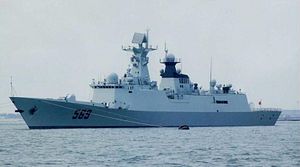The People’s Liberation Army Navy (PLAN) has dispatched three surface warships on a four-day goodwill and training visit to the Pakistani port of Karachi, Chinese state-owned media reported on June 11.
The ships arrived in the port city on June 10 and were welcomed by Chief of Naval Staff of the Pakistan Navy Admiral Mohammad Zakaullah. The small PLAN fleet is commanded by Rear Admiral Shen Hao, the deputy commander of the PLAN’s East Sea Fleet.
The Pakistan Navy and PLAN will conduct a so-called passage exercise to enhance interoperability between the two navies, according to Pakistani military officials. The PLAN fleet consists of three ships, the Type 052C Luyang II –class guided missile destroyer Changchun, the Type 054A Jiangkai II-class guided missile frigate Jingzhou, and the Type 903 Quiandaohu-class replenishment ship Chaohu.
The Luyang II-class, equipped with a four array AESA multi-function phased array radar system and armed with up to 48 vertically launched HQ-9 naval air defense missiles, was the first PLAN class of warships capable of long-range fleet air defense. The class is succeeded by the Type 052D Luyang III-class–dubbed the “Chinese Aegis.” As I explained elsewhere (See: “China Launches Yet Another ‘Carrier Killer’ Destroyer”):
A Type 052D Luyang III-class destroyer is equipped with 64 vertical launch cells, each capable of carrying one to four missiles. The ship carries one of the PLAN’s deadliest anti-ship cruise missiles (ASCM), the vertically-launched YJ-18 ASCM. Next to its YJ-18 arsenal, Type 052D guided-missile destroyers are also equipped with modern HQ-9 surface-to-air-missiles.
The Type 054A Jiangkai II-class guided missile frigate Jingzhou is the 21st ship of the class currently in service with the PLAN and was commissioned in January 2016. Type 054A Jiangkai II-class frigates are multirole warships and have been deployed overseas on multiple occasions including anti-piracy operations in the Gulf of Aden. Around 25 Type 054A Jiangkai II-class frigates are currently in service with the PLAN. At least five more ships of the class are currently under construction. In December 2016, I elaborated on the Type 054A class’ capabilities:
The stealth frigate is armed with HQ-16 medium range air defense missiles and boosts a 32-cell vertical launching system (VLS) in the forward section, capable of firing anti-ship and air defense missiles as well as anti-submarine torpedoes. It also features a Russian-made AK-630 fully automatic naval close in weapon system and a Chinese variant of the AK-176 76 millimeter naval gun.
Some frigates of the class are also known to have been equipped with variable depth sonar and towed array sonar systems. In addition, the ship is equipped with a Type 382 phased-array radar system and Type 344 and Type 345 multifunctional fire control radar systems, capable of over the horizon targeting.
Type 054A frigates also feature a hangar capable of accommodation Kamov K-27 and Harbin Z-9 helicopters or unmanned aerial vehicles (UAVs). (…) The ship has a standard range of about 3,800 nautical miles—7,037 kilometers–at a speed of 18 knots, and a maximum un-refueled radius is 12,000 kilometers or 8,000 miles.
The small PLAN fleet departed Shanghai in April. The three ships are expected to visit 20 countries around the world in the coming months. “This voyage is an innovative way to promote harmonious ideals, peace and friendship,” said Admiral Miao Hua, political commissar of the PLAN, in April, according to China Daily. “It is also a good platform to deepen military-military dialogue and cooperation, and showcase our Navy’s positive image.”
According to the Pentagon’s newly released report on trends and developments on China’s military, Pakistan could become the home of China’s second overseas base following Djibouti on the Horn of Africa. “China most likely will seek to establish additional military bases in countries with which it has a longstanding friendly relationship and similar strategic interests, such as Pakistan, and in which there is a precedent for hosting foreign militaries,” the report states.

































